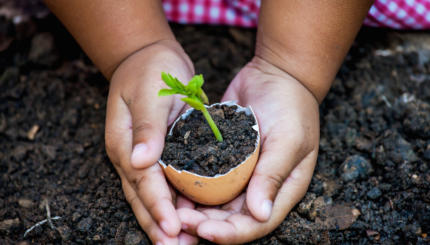, or the “birthday” of all fruit trees, is a minor festival seemingly tailor-made for today’s Jewish environmentalists. In fact, there is an ancient midrash (rabbinic teaching) that states:
When God led Adam around the Garden of Eden, God said, ‘Look at My works. See how beautiful they are, how excellent! For your sake I created them all. See to it that you do not spoil or destroy My world–for if you do, there will be no one to repair it after you.” (Ecclesiastes Rabbah 7:13)
Tu Bishvat in Ancient Times
But it was not always this way. In ancient times, it was merely a date on the calendar that helped Jewish farmers establish exactly when they should bring their fourth-year produce of fruit from recently planted trees to the Temple as first-fruit offerings. After this, all subsequent fruit produced from these trees could be eaten or sold as desired.
Origins of the Tu Bishvat Seder
 Tu Bishvat could easily have faded away after the destruction of the Second Temple in 70 CE, since there was no longer a system of fruit offerings or Temple priests to receive them. However, the kabbalists (mystics) of Tzfat (the city of Safed) in the Land of Israel in the 16th century created a new ritual to celebrate Tu Bishvat called the Feast of Fruits.
Tu Bishvat could easily have faded away after the destruction of the Second Temple in 70 CE, since there was no longer a system of fruit offerings or Temple priests to receive them. However, the kabbalists (mystics) of Tzfat (the city of Safed) in the Land of Israel in the 16th century created a new ritual to celebrate Tu Bishvat called the Feast of Fruits.

Help us keep Jewish knowledge accessible to millions of people around the world.
Your donation to My Jewish Learning fuels endless journeys of Jewish discovery. With your help, My Jewish Learning can continue to provide nonstop opportunities for learning, connection and growth.
Modeled on the Passover seder, participants would read selections from the Hebrew Bible and Rabbinic literature, and would eat fruits and nuts traditionally associated with the land of Israel. According to Deuteronomy 8:8, there are five fruits and two grains associated with Israel as a “land of wheat and barley, of vines [grapes], figs and pomegranates, a land of olive trees, and [date] honey.” The kabbalists also gave a prominent place to almonds in the Tu Bishvat , since the almond trees were believed to be the first of all trees in Israel to blossom. Carob, also known as bokser or St. John’s bread, became another popular fruit to eat on Tu Bishvat, since it could survive the long trip from Israel to Jewish communities in Europe.
Participants in the kabbalistic seder would also drink four cups of wine: white wine (to symbolize winter), white with some red (a harbinger of the coming of spring); red with some white (early spring) and finally all red (spring and summer).
Complete with biblical and rabbinic readings, these kabbalists produced a Tu Bishvat Haggadah in 1753 called “Pri Etz Hadar” or “Fruit of the Goodly Tree.”
Tu Bishvat Meets Modern Zionism

When Zionist pioneers began returning to the land of Israel in the late 19th century, Tu Bishvat became an opportunity for these ardent agrarians to celebrate the bounty of a restored ecology in Israel. In ancient times, the land of Israel was once fertile and well forested. Over centuries of repeated conquest, destructions, and desertification, Israel was denuded of trees. The early Zionists seized upon Tu Bishvat as an opportunity to celebrate their tree-planting efforts to restore the ecology of ancient Israel and as a symbol of renewed growth and flowering of the Jewish people returning to their ancestral homeland.
READ: The Tree Herzl Planted in Israel
In modern times, Tu Bishvat continues to be an opportunity for planting trees — in Israel and elsewhere, wherever Jews live. Many American and European Jews observe Tu Bishvat by contributing money to the Jewish National Fund, an organization devoted to reforesting Israel (the purchase of trees in JNF forests is also customary to commemorate a celebration such as a Bar or Bat-Mitzvah). Many parents donate to the JNF every year on Tu Bishvat in honor of their children.
Tu Bishvat and Environmentalism
For environmentalists, Tu Bishvat is an ancient and authentic Jewish connection to contemporary ecological issues. The holiday is viewed as an appropriate occasion to educate Jews about their tradition’s advocacy of responsible stewardship of God’s creation, manifested in ecological activism. Tu Bishvat is an opportunity to raise awareness about and to care for the environment through the teaching of Jewish sources celebrating nature. It is also a day to focus on the environmental sensitivity of the Jewish tradition by planting trees wherever Jews may live.
The Tu Bishvat seder has increased in popularity in recent years. Celebrated as a congregational event, the modern Tu Bishvat seder is multi-purpose. While retaining some kabbalistic elements–and still very much a ritual that connects participant to the land of Israel–the seder today is often imbued with an ecological message as well. One new custom often found at such seders uses Tu Bishvat as a preparation for the Passover seder. In climates where tree planting is not feasible, participants will plant parsley seeds; the parsley will be used on the Passover seder plate.
Kabbalist, Kabbalistic
Pronounced: KAH-buh-list, kah-buh-LIST-ic, Origin: Hebrew, a Jewish mystic, or something that is related to Kabbalah.



